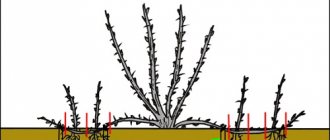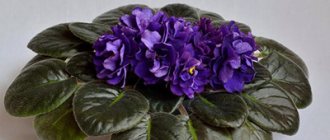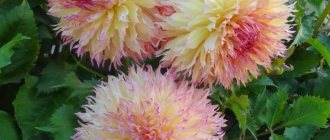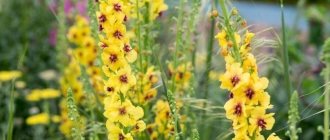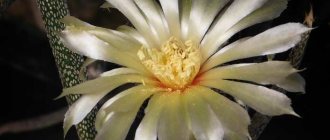The beginning of gooseberry culture in Russia dates back to the 11th century. Its berries are rich in easily digestible sugars and organic acids, contain pectin and vitamins C, B, A, PP. Gooseberries are delicious to eat fresh and can be safely processed into a variety of original preparations - from jams and sauces to wines and jellies. It is also a valuable early honey plant.
Yes, here’s one nuisance - the shoots of this crop are too “spiked”. By the time you reap the harvest, you will be scratched and scratched all over - the same picture occurs when pruning or processing shrubs. Therefore, among many summer residents, gooseberry varieties with weakly thorny shoots are mainly popular. Moreover, among these today you can already choose gooseberries with berries of different sizes, colors and tastes, which are quite unpretentious to growing conditions, productive and resistant to diseases.
We have already told you in detail how to plant and grow such thornless gooseberries on your site, today we will talk about its most successful varieties.
We have tried to compile for you the most popular, productive and sweet varieties of thornless gooseberries - pink, white, red, yellow, green, black - take your pick!
Gooseberry Consul (Senator)
Russian selection variety of medium ripening period.
The variety is self-fertile, winter-hardy, the yield increases gradually with age (from 3 kg from a young plant to 6-7 kg from an adult bush), tolerates short-term drought well, and is highly resistant to diseases. The duration of fruiting is about 40 days.
The bush is vigorous, dense, and quite spreading. The shoots are erect or slightly curved, of small thickness. There are no thorns or there are weak single ones, but in insignificant quantities in the lower part of the shoots.
The leaves are medium-sized, three-lobed, green, slightly shiny, wrinkled, on thin, long, slightly pubescent petioles. The flowers are small, bright, inflorescences are one-, two- or three-flowered.
The berries are medium-sized (3-6 g), one-dimensional, round-oval, red and very dark red in color with clearly visible light veins, with a matte surface without pubescence. The skin is thin but dense, the flesh is tender, aromatic, translucent. The overall taste is sweet and sour, dessert with a hint of kiwi, a universal berry. Transportability is excellent.
Aftercare
Gooseberries are a slow growing plant. The bushes do not increase in volume quickly, but already in the second year they can produce a relatively good harvest. To increase it, it is important to water the bushes regularly, but so that there is no excess moisture. You need to carefully treat the plant during the dry period and 14 days before the start of harvest.
Note! It is recommended to loosen the soil around the bush, but carefully. Otherwise, there is a risk of damaging the root system. Weeds need to be weeded, as they are carriers of pests and various diseases.
Ural thornless gooseberry (Ark)
Russian selection variety of medium ripening period.
The variety is winter-hardy, high-yielding (4-9 kg per bush), demanding on watering, but tolerates short-term drought well, and is resistant to diseases.
The bush is vigorous, slightly spreading, of medium density. Most shoots grow vertically; lateral shoots may deviate slightly to the sides. Thorns are absent or present, but in small quantities, in the lower part of the shoots.
The leaves are medium-sized, three-lobed, dark green, glossy, concave, wrinkled, on small, pubescent petioles. The buds are painted bright crimson. The flowers are medium-sized, pink, and fade over time.
The berries are large (6-9 g), one-dimensional, round-oval, bright green in color with clearly visible light veins, with a matte surface without pubescence. The skin is dense, medium thickness, sour, the flesh is juicy, sweet, and the aroma is pleasant. The berries are easily torn from the branches and are prone to shedding when fully ripe. The general taste is sweet and sour, dessert, universal berries. Transportability in unripe form is excellent.
Green varieties of non-thorny gooseberries
Among the bright variety of dark shades, there are thornless varieties of the traditional green color of gooseberries. These are the varieties:
Variety Malachite, the bush reaches a height of 2 meters, the branches are strewn with elongated berries with thin skin, which have a characteristic tart taste characteristic of green varieties.
The Ural thornless gooseberry is distinguished by a slightly sour taste of the berries; the vigorous bush is resistant to many fungal diseases and is early ripening.
The Grossular variety has oval, drop-shaped berries; they are distinguished by their sugar content and thin skin.; The variety is characterized by resistance to shedding, is suitable for fresh consumption, and does not significantly change color when heated. The berries are ideal for making homemade wines.
- Metal tiles as a roofing material, pros and cons
- Indoor flowers that like to be in the shade
- How to choose a flowerpot
All varieties of thornless gooseberries are worthy of being on your site. The bushes are easy to process and thin out. When harvesting, skin injuries are excluded. Breeders continue to work on creating new varieties zoned for the climatic zones of the Urals and Siberia.
Gooseberry Grushenka
A variety of Russian selection with a medium-late ripening period.
The variety is winter-hardy, medium-yielding (4-6 kg per bush), demanding on soil, tolerates drought well and is overly sensitive to excess moisture. The variety is resistant to powdery mildew, anthracnose and septoria. The variety is early-bearing, but has a short fruiting period.
The bush is medium-sized, semi-spreading, heavily leafy, prone to thickening. The shoots are long, branching, drooping - an adult bush requires garter and regular pruning. There are practically no thorns.
The leaves are medium-sized, five-lobed, green, glossy, slightly wrinkled, on small, hairless petioles. The inflorescences are one-, two- or three-flowered and are borne in large quantities along the shoot.
The berries are medium-sized (3-7 g), one-dimensional, oval-pear-shaped, dark purple (plum) in color, with a matte surface without pubescence. The skin is dense, of medium thickness, the flesh is juicy, sweet and sour, the aroma is pleasant and rich. The berries are not prone to cracking and shedding. The general taste is sweet and sour, dessert, universal berries. Transportability is excellent.
How to trim gooseberries | IN THE GARDEN AND VEGETABLE VEGETABLE
Pruning gooseberries and other fruit trees and shrubs is a constant concern for gardeners. Any plant requires attention and care, and gooseberries also require pruning. How to trim gooseberries
That's right - advice for novice gardeners in this article.
I invite you to the group on Subscribe.ru for summer residents and gardeners:
Pruning gooseberries
Gooseberries have long earned the love and respect of gardeners; this berry can be found in any summer cottage.
It is not only tasty and beautiful, it contains a large amount of vitamins and healthy substances.
The only negative aspect in growing gooseberries was picking the berries, which is a real problem, because the bush has a large number of thorns and sometimes it is almost impossible to get to the berries.
General issues of caring for gooseberries have already been covered on the site, read here.
If the gooseberries are not properly cared for and processed in a timely manner, then over the years they will become very thick, picking the berries will become impossible, the berries will become smaller in size, and the taste will become much worse.
The plant weakens and becomes vulnerable to fungal diseases.
A large number of young shoots take up most of the nutrition, so the gooseberry simply needs pruning.
Gooseberry Commander (Vladil)
Russian selection variety with mid-early ripening period.
The variety is winter-hardy, high-yielding (5-7 kg per bush), unpretentious in cultivation, characterized by good self-fertility, resistant to fungal infections, and practically not affected by aphids, moths and sawflies.
The bush is medium-sized, slightly spreading, of medium density. The shoots are thin, upright, mostly thornless (single thorns are thin and sparse).
The leaves are medium-sized, three- and five-lobed, dark green, glossy, slightly wrinkled, on small, slightly pubescent petioles. The flowers are small, bright pink, collected in two- or three-flowered inflorescences.
The berries are medium-sized (4-5 g), one-dimensional, round-oval, first reddish, then burgundy-brown in color with moderately noticeable light veins, with a matte surface without pubescence. The skin is thin, sweet and sour, the flesh is juicy, sweet, bright crimson, the aroma is pleasant. The berries are not prone to cracking and shedding. The general taste is sweet and sour, dessert, universal berries. Transportability of fruits is low.
Landing nuances
Gooseberry seedlings without thorns can be purchased at a nursery. Like the prickly variety, it is propagated by cuttings and layering. For planting, an area with low groundwater levels is allocated, well illuminated by the sun's rays - the crop does not like waterlogging. It requires fertile soil rich in humus; sandy loam and medium loamy soils are preferred.
The depth of the planting hole is 40-50 cm, the width is similar. The substrate for planting consists of humus (8-10 kg), 1 bucket of fertile soil, potassium sulfate and superphosphate (40 g each). The seedlings are buried 5-7 cm deeper than the root collar - this gives them the opportunity to form additional roots.
After the substrate is compacted, it is watered (0.5 buckets per trunk circle). The earth is mulched with humus. The shoots are shortened, leaving 2-4 buds on each. Already 2 years after planting, gardeners receive their first harvest. It is best to plant thornless gooseberries in the fall, in September-October. If the spring period is chosen, then it is important not to be late with the deadlines.
Thornless gooseberries often have low self-fertility - 2-3 varieties are planted nearby, maintaining a distance of about 1.5 m.
Chelyabinsk gooseberry thornless (slightly thorny)
Russian selection variety with mid-early ripening period.
The variety is self-fertile, winter-hardy, high-yielding (4-8 kg per bush), tolerates short-term drought, is resistant to diseases, and does not tolerate acidified and waterlogged soil.
The bush is medium-sized, compact, dense. The shoots are of medium thickness, slightly curved near the base, pubescent. Thorns are present in small quantities at the bottom of the shoots.
The leaves are medium to large, three-lobed, bright green, glossy, curved, on medium-sized, slightly pubescent petioles. The flowers are medium-sized, lime-colored, collected in two- or three-flowered inflorescences.
The berries are medium and large (3-7 g), one-dimensional, round-oval, dark cherry color, with a matte surface without pubescence, with a waxy coating. The skin is thin, easily separated, the flesh is juicy, sweet, and the aroma is pleasant. The general taste is sweet and sour, dessert, universal berries.
Peculiarities
With the development of decorative gardening, a huge expansion of the range of plants, and the emergence of landscape designers, many gardeners became carried away by a new tempting direction. Owners of land plots suddenly lost interest in fruit trees, berry bushes, and even more so in vegetable beds.
But only 30 years passed and people realized that the most delicious berry grows in their garden. Feeding children overseas fruits is dangerous and useless. Prices for fresh fruits are rising, and quality is deteriorating.
And then Russians began to again become interested in the most delicious, productive and sustainable berries. Making your own jam and making compotes is becoming fashionable again.
During this time, the plants also changed. The raspberries increased in size fivefold, the honeysuckle stopped falling off, the black currants stopped getting sick, and the gooseberries lost their thorns.
The main directions of gooseberry breeding in recent years have been the production of varieties that are resistant to fungal diseases, large-fruited, high taste, improving the biochemical composition of the fruit, thornless, winter-hardy, drought-resistant and heat-resistant.
It has not yet been possible to completely get rid of the thorns. There are varieties:
- weakly prickly;
- with single spikes;
- with spines disappearing during growth;
- with thorns that appear with age.
Many varieties with these characteristics have been bred for the middle zone.
Low thorn varieties:
- Sadko;
- Chernomor;
- Russian;
- Kolobok;
- Spring;
- Eaglet;
- Affectionate.
In the 80s of the 20th century, large-fruited, slightly thorny varieties were developed:
- Crown;
- Snezhana;
- Green rain;
- Charm.
Single spikes:
- at the Jubilee;
- Sirius;
- Eaglet;
- Northern Captain;
- Snezhany.
The following varieties have no thorns:
- Grushenka;
- Glorious;
- Bitsevsky.
Thornless frost-resistant varieties for the North and the Urals:
- Vladil;
- Senator;
- Harlequin;
- Cooperator;
- Beryl;
- Chelyabinsk weak-thorned;
- Ural thornless.
All of them were bred in Chelyabinsk.
Thornless drought- and heat-resistant varieties for the southern regions:
- Lights of Krasnodar;
- Krasnodar.
If the old varieties came from selection with the English gooseberry, which has tasty, large berries, then the new ones were obtained from American varieties.
They are immune to disease, high-yielding, thornless, but have an unexpressed, mealy taste. Therefore, many new varieties are sour and lack a pronounced gooseberry taste.
For example, Grushenka, which is valued for its amazing productivity, thornlessness, and disease resistance. But many criticize it for its inexpressive taste. However, experienced gardeners who are able to create optimal growth conditions for gooseberries talk about its honey taste. Unripe berries are not capable of producing the true taste of the variety.
Gooseberry Northern Captain
A variety of Russian selection with a medium-late ripening period.
The variety is partially self-fertile, winter-hardy, high-yielding (yield increases gradually with age (from 2.5 kg from a young plant to 7-9 kg from an adult bush), demanding watering, but tolerates short-term drought well, resistant to diseases (especially powdery mildew) ) and pests.
The bush is vigorous, wide-spreading, dense. The shoots are highly branched, of medium thickness, and grow obliquely. Thorns are absent or present, but sparse and thin, in small quantities in the lower part of the shoots.
The leaves are large, three-lobed, dark green, glossy, soft, slightly wrinkled, on small, slightly pubescent petioles. The flowers are large, pink-greenish, the inflorescences are two- or three-flowered.
The berries are medium-sized (4-6 g), one-dimensional, round-oval in shape with an expanded base, dark red and dark purple in color, with a matte surface without pubescence, with a waxy coating. The skin is of moderate density, the flesh is juicy, sweet and sour, with a pronounced aroma. The overall taste is sweet and sour, a versatile berry. Transportability and keeping quality are excellent.
Features of planting and caring for gooseberries without thorns
The yield of gooseberries depends on whether the planting rules and care recommendations are followed. Growing a thornless shrub is not much different from cultivating a plant with thorns.
Landing rules
In the shade, gooseberries develop poorly: the shoots will be weakened, the berries will be small, and the taste will be bland. Therefore, the plant is planted in well-lit areas. The soil should be light and nutritious, with neutral acidity. Sandy loam soil is ideal, but clayey areas are best avoided. 4 weeks before planting, dig holes and fertilize them with a mixture of rotted manure and double superphosphate.
Attention! The seedlings are pre-soaked in a growth stimulator, after which all dried shoots and damaged roots are removed. The bush is placed in the hole slightly at an angle, the roots are sprinkled with soil and compacted with hands, then watered with warm water.
Thornless gooseberries are planted in autumn, not spring. This is done 5 weeks before frost, so that before the onset of cold weather the young plant has roots and has time to take root in its new location. The distance between the bushes should be 1.5–2 m, otherwise they will interfere with each other. Compact plants are planted along the fence or made into a hedge.
Growing and care
Throughout the life of the shrub, weeds are regularly removed and the beds are loosened - this guarantees the flow of oxygen to the roots, stimulates photosynthesis and fruit development. Fertilize gooseberries once every 3-4 weeks with fertilizers based on ammonium nitrate, superphosphate, urea, and potassium chloride. Before fertilizing, the plant is watered in dug grooves or trenches.
An important stage in care is the formation of bushes and pruning of excess shoots. In the first 2-3 years, the skeletal branches are shortened and all root shoots are removed. In the 4th year, all diseased and dry shoots, as well as branches growing in a chaotic direction, are pruned. Gooseberries are formed and trimmed at the end of October or March.
The crop is treated against diseases and insect pests. If prevention is not carried out, the plant is attacked by sawflies, mole crickets, aphids, and spider mites. Once a month, the plant is sprayed with soap or tobacco solution. If there are already signs of infection, use a solution of copper sulfate or Bordeaux mixture.
Criteria for choosing a gooseberry variety for planting in the country
Varieties of gooseberries and their varieties differ in size and taste of the fruit. Shrubs may differ in shape, presence or absence of thorns. An important criterion is how adapted the plant is to growing in a given climate.
For example, one variety of gooseberry in one region constantly produces a high yield of delicious fruits, but in another region this gooseberry will grow poorly and often get sick.
The taste of berries can be sour-sweet or sweet-sour. The first option has a good sense of sourness, while option No. 2 has more sweetness.
Owners of garden plots have the opinion that if a gooseberry is greenish in color, it is sour. And if it’s reddish, it will be sweet. But this is a wrong belief.
Each variety has its own taste. It is impossible to judge the taste characteristics by the shade of gooseberry fruits (whether they are red, yellow, green or pink).
Gooseberries are conventionally divided into three subgroups.
- The 1st subgroup includes American.
- Ko 2nd – European.
- To the 3rd - American - European, or hybrid.
The European variety includes varieties that have large fruits with a rich taste. Only they have weak immunity to characteristic diseases, and reproduce poorly.
The American subgroup is characterized by the presence of medium-sized berries. They taste mediocre. But these varieties have a characteristic feature - high immunity to diseases. They reproduce well.
Hybrids have their own characteristics. They take the best characteristics from their parents. They tend to bear fruit abundantly.
